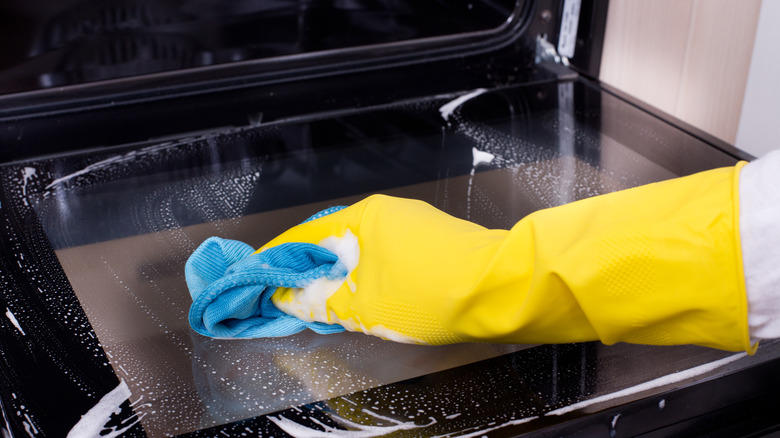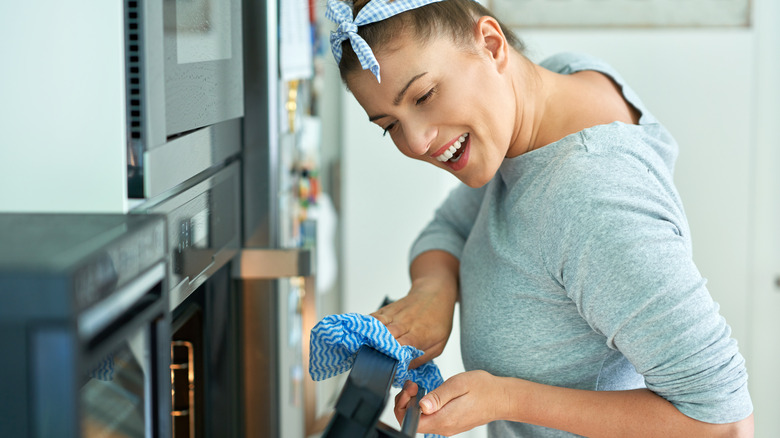Save Your Dirty Oven Doors With This Hydrogen Peroxide Hack
Cleaning the inside of oven doors can be a real hassle because, let's face it, it's like a secret chamber for splattered sauces and mysterious drips. The combination of high temperatures and cooking shenanigans turns those innocent spills into stubborn, baked-on grime. Plus, contorting yourself to reach those awkward corners feels like a yoga challenge. It's a battleground that demands time and elbow grease, but the satisfaction of seeing it sparkly clean is like winning a hard-fought culinary victory. Fortunately, your neglected bottle of hydrogen peroxide is the secret ingredient you need to get those doors looking brand new again.
Hydrogen peroxide offers several benefits over traditional chemical cleaners. First, it's environmentally friendly, made up of water and oxygen, minimizing harmful residues. Additionally, hydrogen peroxide lacks harsh chemicals, reducing the risk of skin irritation or respiratory issues. Its versatility shines in stain removal, mold and mildew control, and disinfection. As a disinfectant, hydrogen peroxide is effective against a variety of microorganisms. With its broad applications and safer profile, hydrogen peroxide stands out as a multipurpose and eco-conscious cleaning solution, perfect for tackling stubborn stains on the inside of your oven's doors. It's also cost-effective, often more affordable than commercial alternatives.
How to use hydrogen peroxide to clean your oven doors
To tackle those difficult stains and clean the inside of oven doors effectively using hydrogen peroxide, start by creating a DIY cleaning solution. Mix two parts baking soda with one part hydrogen peroxide and one part dish soap in a bowl. This combination forms a powerful yet gentle cleaner that effectively tackles grime and grease. Next, prepare the oven door by removing any loose debris or large particles. Apply the cleaning solution to the inside of the oven door, focusing on areas with visible stains or built-up residue. Allow the mixture to sit overnight to reduce the amount of scrubbing required, and in the morning, use a sponge or a soft-bristle brush to clear away the grime.
For really tough spots, consider placing a boiling pot of water inside the oven while you let the hydrogen peroxide mixture work its magic on the oven's interior surfaces. Allowing the boiling water to sit inside the oven for at least an hour will provide steam that will aid stain removal and reduce the amount of scrubbing necessary. Wipe down the entire inside of the oven door with a damp cloth to remove the cleaning solution. Then, dry the door with a clean, dry cloth. This method harnesses the cleaning power of hydrogen peroxide, baking soda, and dish soap to efficiently remove grease and stains inside oven doors, leaving them looking clean and refreshed.
Why hydrogen peroxide works well on your oven doors
Hydrogen peroxide, when paired with baking soda and dish soap, forms a potent cleaning solution for tackling the tough, baked-on grime on the inside of oven doors. Hydrogen peroxide is a powerful oxidizing agent that excels at breaking down and lifting stains. It releases oxygen upon application, creating a bubbling action that helps dislodge and lift dirt from surfaces. This effect is particularly effective in loosening stubborn, baked-on grease and grime, making it easier to wipe away.
Baking soda, another crucial component, acts as a mild abrasive. Its gritty texture aids in scrubbing away residue without causing damage to the underlying surface. Baking soda also possesses natural deodorizing properties, helping neutralize any unpleasant odors in the oven. Its abrasive nature, combined with its ability to react with hydrogen peroxide, enhances the overall cleaning power of the solution, ensuring a thorough removal of stains and build-up.
Dish soap contributes to the cleaning solution by providing a degreasing element. It breaks down and emulsifies grease, making it easier to lift off surfaces. Combining dish soap with hydrogen peroxide and baking soda creates a well-rounded solution targeting different aspects of oven grime. The detergent action of dish soap enhances the solution's overall effectiveness. Together, these ingredients form a powerful mixture that delivers an efficient solution for cleaning oven doors.


